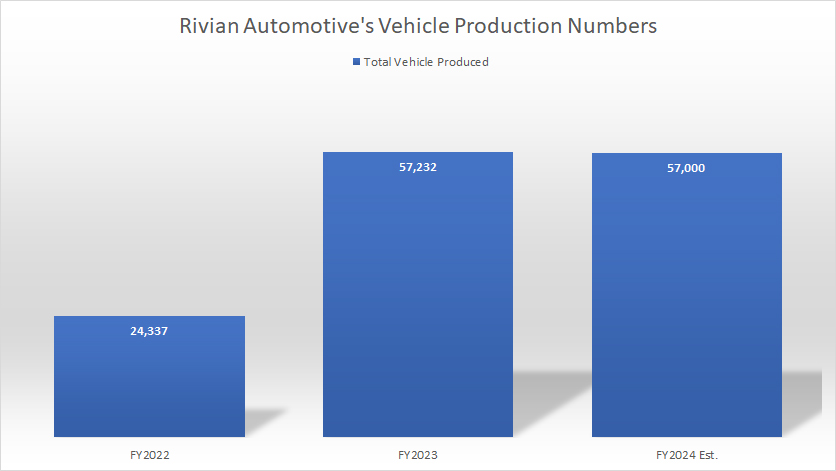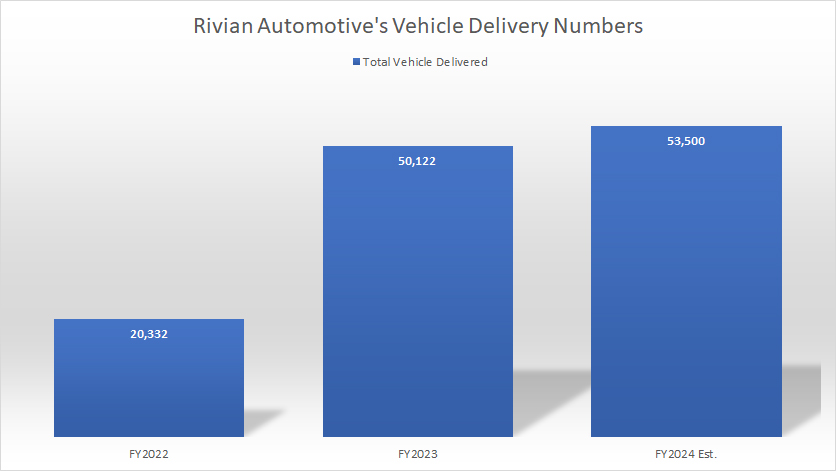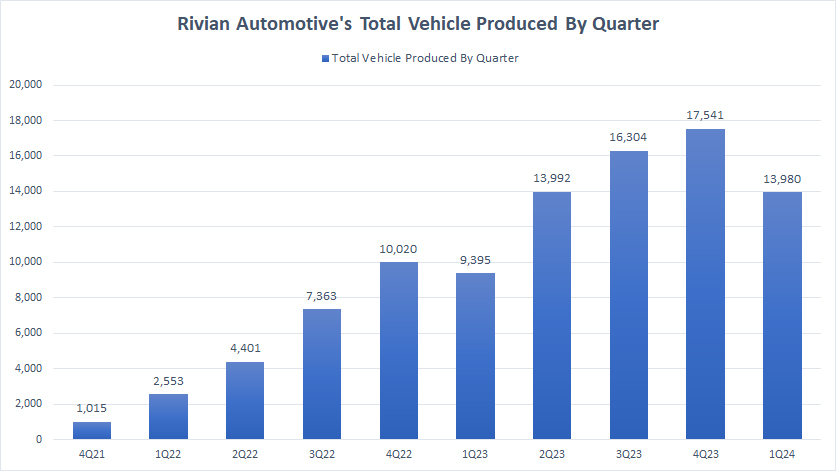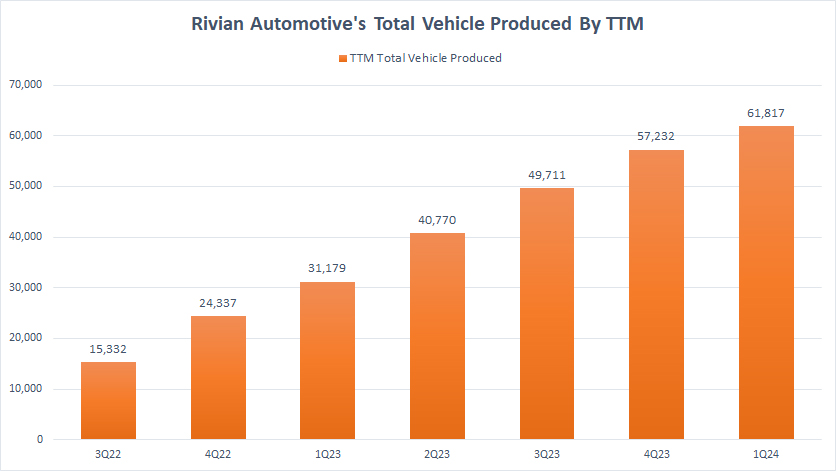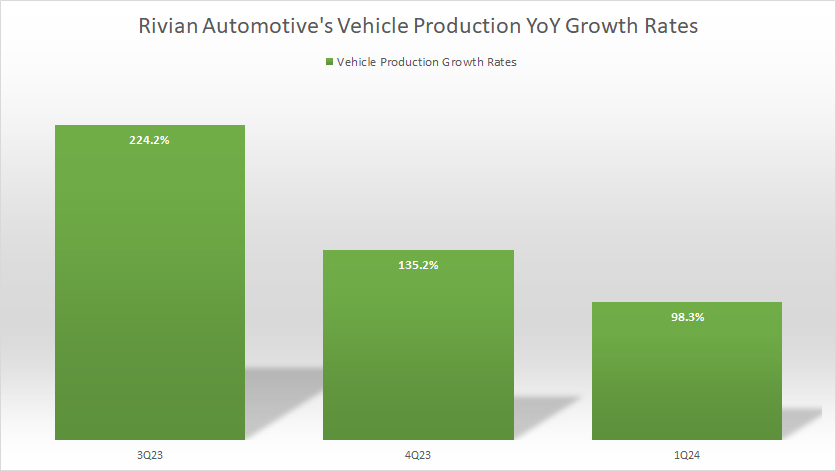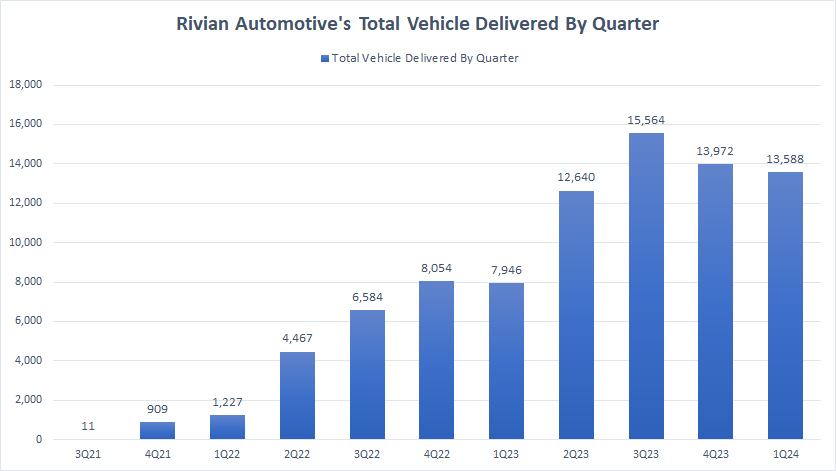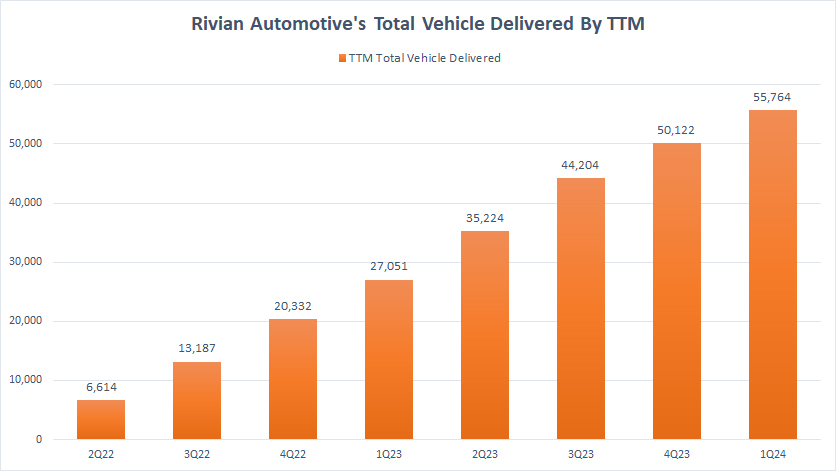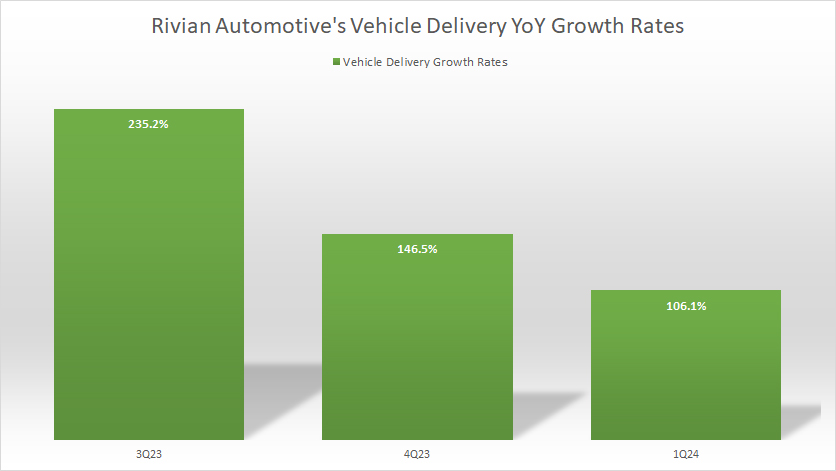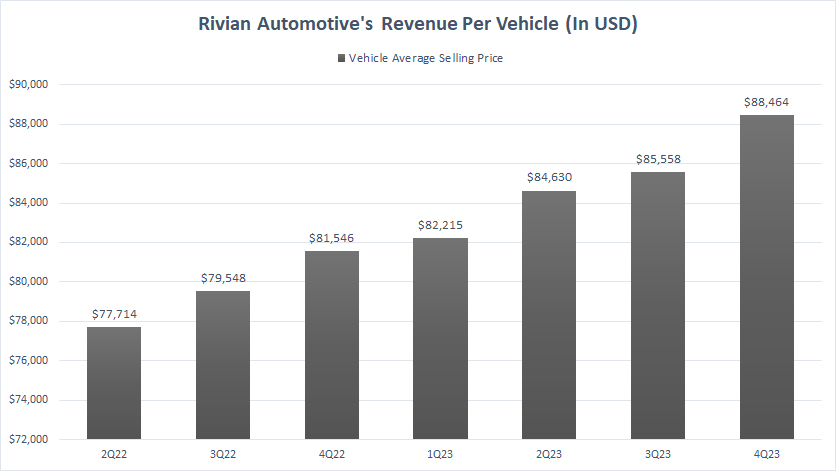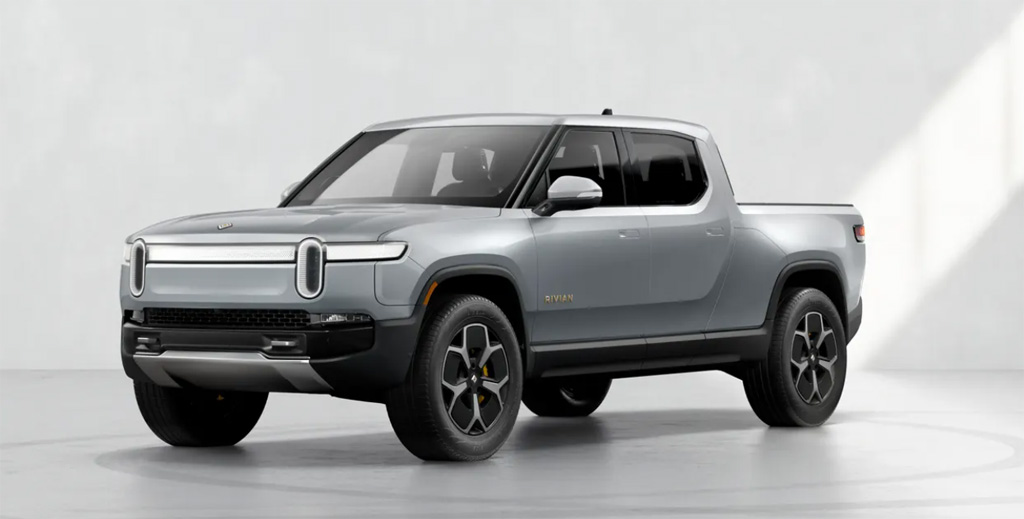
Rivian R1T. Image By Rivian
Rivian Automotive (RIVN) is a U.S. automobile company specializing in the design, development, and manufacture of electric trucks, SUVs, and commercial vans.
Rivian’s products include not only the vehicles but also the software and accessories, as well as value-added services that directly address the vehicle’s entire lifecycle.
Rivian’s products for the consumer market include the R1 electric truck and R1 utility vehicle. On the other hand, Rivian’s products for the commercial market include electric delivery vans, which the company has agreed to produce up to 100,000 units for Amazon. As of the end of 2023, Rivian’s sales to Amazon represented 19% of the company’s total revenue.
Rivian’s current vehicles are based on the R1 manufacturing platform. The company is making progress to launch the R2 platform in 2026, which is intended to be more sophisticated but cost less to produce.
For your information, the R2 will be Rivian’s first high-volume manufacturing platform in Georgia, a separate location from the existing R1 platform in Normal, Illinois. Rivian said that the R2 will be a game changer for the company as the R2 vehicles will be the company’s first mass-market products.
This article looks at several statistics which include Rivian’s sales and production, revenue per car, outlook, and growth rates.
Let’s get started.
Please use the table of contents to navigate this page.
Table Of Contents
Definitions And Overview
O2. How Does Rivian Distribute Its Vehicles?
Vehicle Production, Delivery, And Outlook
A1. Vehicles Produced By Year And 2024 Outlook
A2. Vehicles Delivered By Year And 2024 Outlook
Production Results By Quarter
B1. Vehicles Produced By Quarter
B2. Vehicles Produced By TTM
B3. YoY Growth Rates Of Vehicles Produced By TTM
Delivery Results By Quarter
C1. Vehicles Delivered By Quarter
C2. Vehicles Delivered By TTM
C3. YoY Growth Rates Of Vehicles Delivered By TTM
Vehicle Pricing
Conclusion And Reference
S1. Summary
S2. References and Credits
S3. Disclosure
Definitions
To help readers understand the content better, the following terms and glossaries have been provided.
Revenue Per Vehicle: Revenue per vehicle is a financial metric often used in industries where businesses generate income by selling or leasing vehicles.
It measures the average revenue generated from each vehicle in a given period. This metric is particularly relevant in the automotive industry, car rental services, and companies involved in leasing vehicles. It provides insight into the profitability and efficiency of a company’s sales and leasing strategies.
Calculating revenue per vehicle involves dividing the total revenue earned from vehicles by the number of vehicles sold or leased in the same period. This indicator helps businesses assess their performance, make informed pricing and inventory decisions, and strategize to improve profitability.
How Does Rivian Distribute Its Vehicles?
Rivian, unlike traditional automakers, adopts a direct-to-consumer sales model, meaning they sell vehicles directly to customers without relying on independent dealerships. This approach is similar to what other electric vehicle manufacturers, such as Tesla, have implemented. Here’s a breakdown of how Rivian distributes its vehicles:
1. **Online Sales**: Customers can order vehicles directly from Rivian’s website. Before placing an order, this process allows for vehicle customization, including model type, color, and additional features.
2. **Rivian Showrooms and Experience Centers**: Rivian is also opening physical locations where potential buyers can view models, ask questions, and take test drives. These centers are strategically placed in high-traffic areas to increase brand visibility and customer engagement. However, the purchase process is completed online, even in these physical locations.
3. **Delivery**: Rivian coordinates the delivery of the new vehicle directly to the customer’s preferred address after purchasing a vehicle. This direct delivery method enhances the customer experience by making the process more personal and convenient.
4. **Service Centers and Mobile Service**: Rivian is establishing a network of service centers for maintenance and service. Additionally, they offer mobile service, where technicians come to the vehicle’s location, reducing the need for owners to visit a service center.
This distribution approach allows Rivian to maintain control over the sales process, provide a consistent brand experience, and potentially reduce costs associated with traditional dealership networks. Direct sales models in the automotive industry are somewhat controversial and face legal challenges in some states in the U.S., where laws traditionally favor the dealership model. However, Rivian, like other EV manufacturers, is navigating these challenges by advocating for changes to these laws and finding innovative ways to reach customers within the current legal framework.
Vehicles Produced By Year And 2024 Outlook
Rivian-vehicle-production-figures-and-outlook
(click image to expand)
Rivian produced 24,000 vehicles in 2022 and 57,232 vehicles in 2023. Rivian expects production to be flat in fiscal 2024, with up to 57,000 vehicles produced by the end of the fiscal year.
These figures include all vehicle types, including its electric cars for the consumer market and the electric vans for the commercial market.
Vehicles Delivered By Year And 2024 Outlook
Rivian-vehicle-delivery-figures-and-outlook
(click image to expand)
Rivian delivered 20,322 vehicles in 2022 and 50,122 vehicles in 2023. Rivian may deliver up to 53,500 vehicles midpoint by the end of the fiscal year 2024 since production is expected to be flat in the same year.
Vehicles Produced By Quarter
Rivian-vehicles-produced-by-quarter
(click image to expand)
Rivian’s quarterly vehicle production has averaged 14 thousands vehicles per quarter between 1Q 2023 and 1Q 2024, more than double the average number measured in 2022.
As of 1Q 2024, Rivian produced 13,980 vehicles, nearly 50% higher from a year ago.
Vehicles Produced By TTM
Rivian-vehicles-produced-by-ttm
(click image to expand)
As of 1Q 2024, Rivian’s total vehicles produced reached a record figure of 61,800 units on a TTM basis, double the 31,000 vehicles produced during 1Q 2023.
Therefore, Rivian will likely exceed its production target of 57,000 units by the end of fiscal 2024.
YoY Growth Rates Of Vehicles Produced By TTM
Rivian-vehicles-production-growth-rates
(click image to expand)
In 1Q 2024, Rivian’s vehicle produced was up 98% over the same quarter a year ago. The growth rate has significantly decreased from the 224% measured in 3Q 2023.
Vehicles Delivered By Quarter
Rivian-vehicles-delivered-by-quarter
(click image to expand)
Rivian’s quarterly vehicle delivered averaged 12,700 units per quarter between 1Q 2023 and 1Q 2024, about triple the average figure measured in 2022.
As of 1Q 2023, Rivian’s total vehicles delivered reached 13,600 units compared to 7,900 units reported a year ago.
Vehicles Delivered By TTM
Rivian-vehicles-delivered-by-ttm
(click image to expand)
Rivian delivered a record figure of 55,800 vehicles in 1Q 2024 on a TTM basis, double the figure measured in the same period a year ago.
YoY Growth Rates Of Vehicles Delivered By TTM
Rivian-vehicles-delivery-growth-rates
(click image to expand)
Rivian’s vehicle sales YoY growth totaled 106% in 1Q 2024. The growth rate has significantly decreased from the 235% measured in 3Q 2023.
Revenue Per Vehicle
Rivian-revenue-per-vehicle
(click image to expand)
The revenue per vehicle is calculated as total revenue recognized divided by the number of vehicles delivered.
The definition of Rivian’s revenue per vehicle is available here: revenue per vehicle.
That said, Rivian’s revenue per vehicle has significantly risen since 2022, reaching $88,500 as of 4Q 2023, a record figure since 2022.
Rivian’s revenue per vehicle is higher than most automobile companies, as presented in this article – revenue per vehicle of major automobile companies.
Tesla earned revenue per vehicle of only $53,000. At the same time, those of Chinese automakers were much lower, according to this article – Tesla versus Nio, Xpev, And Li Auto in revenue per vehicle.
Rivian needs to bring its vehicle selling price down to target the mass EV market.
Conclusion
Rivian Automotive is a relatively young automobile company expecting to produce up to 60,000 vehicles in 2024.
Apart from that, Rivian has a much higher vehicle selling price or revenue per vehicle compared to other EV makers.
To remain competitive in the EV market, Rivian has to bring its cost down and, therefore, the revenue per vehicle delivered.
Can the upcoming R2 platform be the game-changer for Rivian? We will keep our fingers crossed.
References and Credits
1. All financial figures presented in this article were obtained and referenced from Rivian Automotive, Inc.’s annual and quarterly reports, shareholder letters, press releases, vehicle production, and delivery reports, earnings calls, etc., which are available in Rivian Investor Relations.
2. Images were obtained from Rivian R1S.
Disclosure
References and examples such as tables, charts, and diagrams are constantly reviewed to avoid errors, but we cannot warrant the total correctness of all content.
The content in this article is for informational purposes only and is neither a recommendation nor a piece of financial advice to purchase a stock.
If you find the information in this article helpful, please consider sharing it on social media and provide a link back to this article from any website so that more articles like this can be created in the future.
Thank you!

